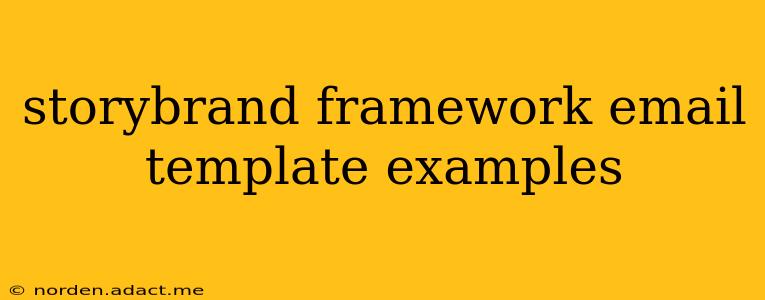The StoryBrand framework provides a powerful structure for crafting compelling marketing messages that resonate with your audience. By positioning your brand as a helpful guide, you can build trust and drive conversions. This post provides several email template examples demonstrating the StoryBrand framework in action, catering to different needs and stages of the customer journey.
Understanding the StoryBrand Framework in Email Marketing
Before diving into the examples, let's briefly recap the seven key elements of the StoryBrand framework:
- Character (Your Customer): Focus on the customer's needs and desires.
- Problem: Clearly define the customer's pain points.
- Plan: Offer a clear solution to their problem.
- Guide (Your Brand): Position your brand as the helpful guide who can help them achieve their goals.
- Call to Action (CTA): Tell the customer exactly what to do next.
- Success: Paint a vivid picture of what success looks like after using your product or service.
- Obstacle: Acknowledge potential challenges and reassure your customers that you'll be there to support them.
Email Template Examples using the StoryBrand Framework
Here are several email templates showcasing the StoryBrand framework in different scenarios:
1. Welcome Email: Onboarding New Subscribers
Subject: Welcome to [Your Brand Name]! Let's Get Started
Hi [Customer Name],
Thanks for joining the [Your Brand Name] community! We're thrilled to have you. We understand that [Problem: feeling overwhelmed/struggling with X/uncertain about Y]. That's why we're here to guide you.
[Plan: Our resources will help you overcome this by...] We'll provide you with the tools and support you need to [Success: achieve your goals/solve your problem/feel confident about X].
[Call to Action: Check out our free guide on X: [Link]]
We're excited to help you on your journey!
Sincerely,
The [Your Brand Name] Team
2. Promotional Email: Highlighting a New Product/Service
Subject: Finally! A Solution for [Customer Problem]
Hi [Customer Name],
Are you tired of [Problem: dealing with X/struggling with Y/wasting time on Z]?
You're not alone. Many of our customers felt the same way until they discovered [Your Product/Service]. [Plan: It's designed to help you overcome these challenges by...].
[Guide: We’re here to guide you every step of the way.] [Success: Imagine finally having X/achieving Y/saving time on Z.]
[Call to Action: Learn more and get started today: [Link]]
Don't wait any longer to reclaim your time and energy.
Best regards,
The [Your Brand Name] Team
3. Email Series: Nurturing Leads
Email 1 (Subject: Overcoming [Specific Problem]): Focuses on a particular pain point and positions your product as the solution.
Email 2 (Subject: Three Steps to [Desired Outcome]): Outlines a simple plan using your product or service.
Email 3 (Subject: Success Stories): Showcases testimonials and case studies. (Focuses on Success)
Email 4 (Subject: Addressing Your Concerns): Acknowledges potential obstacles and offers reassurance.
4. Reminder Email: Cart Abandonment
Subject: Did you forget something?
Hi [Customer Name],
We noticed you left some items in your cart. We understand that [Problem: making a big decision/finding the right product/uncertain about the value].
[Plan: Let us help you! ] [Guide: We’re here to answer your questions.] [Success: Imagine how much easier your life will be with X!]
[Call to Action: Complete your order now: [Link]] We're here to help if you need any assistance.
Thanks,
The [Your Brand Name] Team
Key Considerations for Success
- Segmentation: Tailor your emails to specific customer segments for maximum impact.
- Personalization: Use the customer's name and personalize the message as much as possible.
- Testing: A/B test different subject lines, body copy, and CTAs to optimize your results.
- Consistency: Stick to a consistent email schedule to keep your brand top-of-mind.
By incorporating these examples and adhering to the StoryBrand framework, you can create engaging emails that connect with your audience on a deeper level and ultimately drive conversions. Remember that the key is to consistently place your customer at the center of your message.
